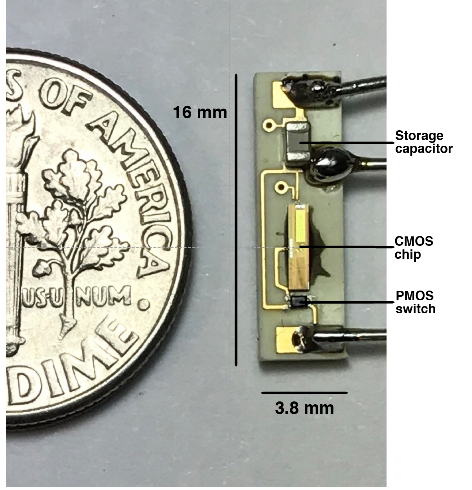By Jean-Jacques DeLisle, contributing writer
By 2030, almost 20% of the U.S. population will be geriatrics, and the high stress and obesity rates indicate that there may be a significant rise in heart complications and disease, according to the U.S. Census Board. This means that millions of Americans may require lifesaving implantable cardiac pacemakers within the next decade. A drawback that implantable pacemakers currently face — the need for periodic surgery to replace batteries — may soon be solved.
Addressing one of the greatest burdens for heart patients equipped with implantable pacemakers, a group composed of researchers from Rice University and the Texas Heart Institute (THI) have developed a wirelessly powered, battery-less implantable cardiac pacemaker, effectively eliminating the need for repeat surgeries for pacemaker battery maintenance and replacement.

This minute battery-less pacemaker developed by researchers from Rice University and the Texas Heart Institute is able to be powered wirelessly from an external battery and eliminates the need for repeat battery replacement surgeries for heart patients. Credit: Rice Integrated Systems and Circuits/Rice University. (Photo by Jeff Fitlow/Rice University.)
The wirelessly powered pacemaker, designed by professor Aydin Babakhani of the Rice University lab of electrical and computer engineering, can harvest radio frequency energy transmitted from an external battery source that can be up to centimeters away from the pacemaker implant. The prototype was presented at the International Microwave Symposium 2017 in Honolulu, Hawaii.
Traditional pacemakers use electrical signals to stimulate areas of a patient’s heart to help reduce arrhythmias. These pacemakers must be implanted within a patient’s chest along with the accompanying battery power, leads, and casing. According to THI, a standard pacemaker battery requires replacement every seven to eight years. In the next decade, with the predicted increased number of pacemaker implantations, this could mean millions of original pacemaker implantation surgeries and millions of additional surgeries to service those, and current, pacemakers. Moreover, the pacemaker battery leads, being electrically active, and the pacemaker batteries themselves are potential causes for internal bleeding and infection in a patient. Professor Babakhani believes that Rice’s prototype reduces these risks by removing the need for the battery leads and battery implantation along with the pacemaker.
“This technology brings into sharp focus the remarkable possibility of achieving the ‘Triple Crown’ of treatment of both the most common and most lethal cardiac arrhythmias: external powering, wireless pacing, and — far and away most importantly — cardiac defibrillation that is not only painless but is actually imperceptible to the patient,” said Dr. Mehdi Razavi, assistant professor at Baylor College of Medicine and director of clinical research and innovation at Texas Heart Institute, who worked alongside professor Babakhani.
Though wirelessly powered pacemaker technology has been sought after for some time, previous attempts at leadless pacemakers may be limited to a single heart chamber and cannot deliver dual-chamber, or biventricular, pacing. The novelty of the Rice University and THI wirelessly powered and battery-less pacemaker is that their pacemaker is powered by a chip less than 4 millimeters wide. This chip is able to harvest energy in the 8-GHz to 10-GHz radio frequency spectrum and only requires a small surface-mount technology (SMT) capacitor and switch on the same board.
The team was able to successfully control a pig’s heart rate from 100 to 172 beats per minute with a prototype device. The team will continue developing the technology and will be collaborating with researchers from Rice University and the University of California San Diego. Future developments of this technology could spare millions of heart patients additional surgeries and potential complications for implanted batteries and electric leads.
Advertisement
Learn more about Electronic Products Magazine





